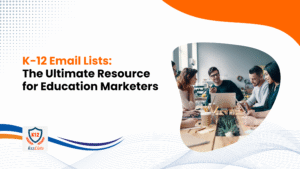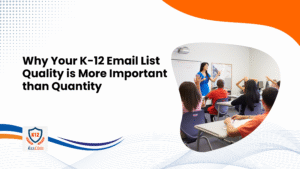In the rapidly evolving world of education marketing, targeting the right audience with precision can make all the difference. If you’re an EdTech company, training provider, or education consultant, success in 2025 and beyond hinges on reaching the right decision-makers within schools and districts. A high-quality K-12 marketing email list is one of the most effective tools for doing so.
However, buying an email list isn’t as simple as purchasing a large batch of contacts. You need a verified, high-quality email list that accurately targets the right people at the right time. The key to success lies in understanding what makes a quality list and how to choose the right provider for your needs.
In this ultimate checklist, we’ll walk you through the steps to buying a quality K-12 marketing email lists and show you how to use it to reach decision-makers effectively.
Why K-12 Marketing Email List Matter
The K-12 education sector is vast and complex. With over 130,000 K-12 schools across the U.S. alone, the number of decision-makers in education is significant. The challenge, however, is not just finding them but reaching them effectively.
When you purchase a high-quality K-12 email lists, you’re investing in a powerful tool that enables you to connect directly with decision-makers such as superintendents, principals, curriculum directors, and IT heads. These are the professionals who have the authority to make decisions about educational products, services, and technologies.
Without access to verified K-12 email lists, your marketing efforts are likely to fall flat. A generic, unverified list often leads to low open rates, high bounce rates, and wasted marketing dollars. This is where the importance of targeting the right audience comes into play. A high-quality, segmented list ensures that your message reaches those who matter most.
Understand Your Target Audience in the K-12 Market

Before buying any K-12 email list, it’s critical to understand who you want to reach. Schools and districts are complex organizations with many different roles and layers of decision-makers.
The key decision-makers typically include:
- Superintendents: These are the top decision-makers responsible for district-wide policies, budgets, and strategic initiatives.
- Principals and Vice Principals: These individuals oversee day-to-day operations within individual schools and are often involved in selecting learning tools, school management systems, and educational resources.
- Curriculum Directors: Responsible for overseeing the adoption of educational materials and tools, making them ideal targets for EdTech providers and content publishers.
- IT Directors and Technology Coordinators: They make decisions about the technology infrastructure within schools, including software, hardware, and e-learning platforms.
- Purchasing Officers: Often involved in procurement, these individuals manage contracts and purchases for educational materials and tools.
Understanding these roles and segmenting your email list by job title, grade level, location, and other factors ensures that your marketing efforts are targeted and relevant.
How to Choose a Reliable K-12 Email List Provider
Once you understand your target audience, the next step is selecting a reliable K-12 email list provider. Not all data providers are equal, and the quality of the list you purchase can significantly impact the effectiveness of your campaign.
When choosing a provider, keep these factors in mind:
- Verified and Updated Data: A good provider will offer lists that are verified regularly. Email addresses that are outdated or incorrect can lead to high bounce rates, decreased deliverability, and lower ROI. Make sure that the provider updates their lists frequently to ensure accuracy.
- Compliance: Ensure that the provider’s data adheres to privacy laws like FERPA (Family Educational Rights and Privacy Act), CAN-SPAM, and GDPR. These laws are crucial in the education sector to ensure that your emails comply with regulations, protecting your reputation and helping you avoid legal issues.
- Transparent Sourcing: Trustworthy data providers will offer transparency on how they collect, verify, and source their data. Avoid providers who use questionable sources or do not offer insight into how the list was built.
- Customer Reviews and Testimonials: Look for providers who have proven experience and a positive reputation. Customer reviews, case studies, and testimonials can provide insight into the provider’s reliability and data quality.
The Key Elements of a Quality K-12 Email List

When you’re shopping for a K-12 email list, make sure that the following elements are included:
- Data Accuracy: The cornerstone of any quality email list is accuracy. An inaccurate email list can hurt your campaigns and waste your marketing budget. Ensure that the email list you purchase has been verified within the last six months to ensure high deliverability.
- Segmentation: A well-segmented list can greatly increase the effectiveness of your campaigns. A good list should allow you to segment by:
- Role (Superintendent, Principal, IT Director, etc.)
- Geography (School district, state, city)
- School Type (Public vs. private, K–12, high school, etc.)
- Grade Level (Elementary, middle school, high school)
Proper segmentation allows for personalized communication, which is far more likely to result in higher engagement and conversions.
- Contact Validation: The list should be validated regularly to remove inactive or incorrect contacts. Using an invalid email list can lead to high bounce rates, damage your sender reputation, and ultimately affect your ROI.
- Comprehensive Data: Ensure that the list includes decision-makers at the district level as well as those at the school level. The more detailed the data, the more effective your outreach can be.
What to Avoid When Buying K-12 Email List
While it may be tempting to buy cheap or large email lists, there are several pitfalls to watch out for:
- Low-Quality Lists: Avoid buying generic or outdated lists. These lists may include contacts who are no longer at their positions, leading to high bounce rates and poor engagement.
- Lack of Transparency: Be cautious of providers who cannot explain where their data comes from or how it is sourced. The lack of transparency in list-building practices can lead to issues with data integrity.
- Non-Compliant Data: If the list doesn’t comply with regulations like CAN-SPAM, FERPA, or GDPR, you run the risk of facing legal action, not to mention damaging your brand reputation.
- Quantity Over Quality: It’s easy to get caught up in the idea of having a large email list, but quality always trumps quantity. A list filled with unverified, irrelevant contacts is far less effective than a smaller, well-targeted, and verified list.
Benefits of Investing in Verified K-12 Email Lists
When you invest in a verified K-12 email list, the benefits are clear:
- Improved Engagement and ROI: A verified list ensures that your emails reach real decision-makers who are genuinely interested in your product or service. This results in higher open rates, better engagement, and ultimately a better ROI.
- Increased Deliverability: Verified lists help ensure your emails don’t land in spam folders or bounce back, allowing your messages to reach the intended inbox without interruption.
- Cost Savings: By reaching the right people, you reduce the cost per acquisition and increase the chances of converting leads into clients. Sending emails to people who are interested in your product means better conversion rates with fewer wasted emails.
- Better Targeting: Verified lists allow for precise targeting based on key segments like geography, role, or school type, ensuring that your message resonates with the right audience.
Tips for Maximizing the Impact of Your K-12 Email Campaigns

Once you’ve purchased a verified K-12 email list, it’s time to make your outreach as effective as possible. Here are some tips:
- Personalize Your Messages: Personalization is key to standing out. Tailor your email content based on the recipient’s role and institution type (e.g., K–12 schools, private schools, charter schools). Mention how your product or service aligns with their specific needs.
- Timing is Everything: Be mindful of the school year and budget cycles. Targeting your emails just before or after the school year begins, or around budget planning periods, increases the chances that your outreach will be seen by decision-makers.
- Follow-Up with Valuable Content: Don’t just rely on the first email. Follow up with additional useful content like case studies, whitepapers, or product demos that provide value and further engage your audience.
Start building smarter campaigns with targeted, actionable data that drives results.
To get your customized K-12 email list and watch your engagement soar!
Final Thoughts: Make Every Email Count
The key to success in education marketing lies not in sending more emails, but in sending smarter emails. By purchasing a verified K-12 email list, you’re ensuring that your outreach reaches the right people at the right time.
To make your K-12 email campaigns as effective as possible, focus on quality over quantity, segment your audience, and use personalized content to increase engagement.
Remember: effective email marketing for the K-12 sector is about building long-term relationships with decision-makers who have the power to shape educational outcomes. So, take the time to choose a quality email list provider, and watch your engagement and ROI soar.
Ready to Reach the Right Decision-Makers in K-12 Education?
Don’t waste time or resources on outdated or generic email lists. Get a verified, high-quality K-12 email list today and connect directly with the key decision-makers who matter most.
FAQs
Focus on decision-makers such as superintendents, principals, curriculum directors, and IT heads for maximum impact.
The best time to reach out is often around the back-to-school period or during budget planning cycles, which are typically in the late spring or early fall.
With our segmented email lists (based on role, school type, or geographic region), you can send personalized messages that address the specific needs and challenges of each group, significantly increasing open rates and engagement.
Yes, our targeted email lists offer global coverage for K-12 schools, allowing you to target specific regions or countries and make your outreach truly international.
A verified list ensures that the email addresses are accurate, up-to-date, and actively used. This is important because it improves deliverability, reduces bounce rates, and ensures your message reaches the right decision-makers.






